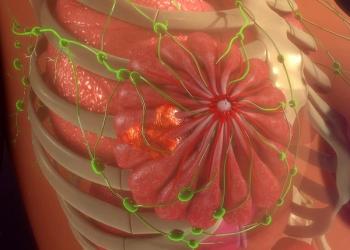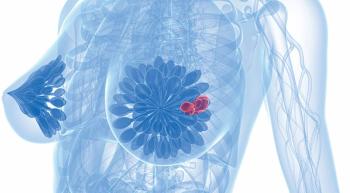
Adjuvant cCRT Improves Disease Control, But Increases AEs in Breast Cancer
Concurrent chemoradiation yielded similar contralateral breast recurrence outcomes vs a sequential approach in early-stage breast cancer.
Adjuvant treatment with concurrent chemoradiation improved locoregional control compared with sequential chemoradiation (CRT) in patients with early-stage breast cancer. However, the concurrent approach was linked with a higher rate of breast fibrosis and telangiectasia, according to results of a systemic review and meta-analysis presented at the
Results showed that locoregional recurrence was lower in patients undergoing concurrent CRT vs sequential CRT (odds ratio [OR], 0.58; 95% CI, 0.43-0.78; P <.01); however, there were no differences between the 2 groups with regard to contralateral breast recurrence (OR, 0.78; 95% CI, 0.44-1.39; P = .46), distant recurrence (OR, 1.04; 95% CI, 0.82-1.32; P = .76), overall survival (OS; HR, 1.02; 95% CI, 0.87-1.19; P = .82), or disease-free survival (DFS; HR, 1.00; 95% CI, 0.87-1.14; P = .95).
Furthermore, the concurrent CRT approach was more commonly linked with moderate or severe breast subcutaneous fibrosis (OR, 2.38; 95% CI, 1.15-4.91) and telangiectasia (1.86; 95% CI, 1.00-3.44) compared with sequential CRT. There were no statistically significant differences reported with lymphedema (OR, 1.22; 95% CI, 0.87-1.71) and severe skin toxicity.
“Adjuvant therapy delivered via concurrent chemoradiation improved locoregional control at a cost of increased breast fibrosis and telangiectasia,” lead study author Luiz F. de Almeida, MD, of the Department of Clinical Medicine at Universidade Federal Fluminense, of Rio de Janeiro, Brazil, and coinvestigators wrote in the poster presented at the meeting.1 “No differences were observed in DFS or OS.”
For patients with early-stage breast cancer, breast-conserving surgery followed by adjuvant radiation is a standard treatment; for those at higher risk of distant recurrence, adjuvant chemotherapy is recommended. However, there are limited data on the optimal sequencing approach of the 2 adjuvant treatment regimens.
For the systemic review and meta-analysis, investigators did a systematic search for randomized, controlled trials that were comparing concurrent and sequential adjuvant chemoradiation. Locoregional recurrence in breast, contralateral breast, and nodal recurrence; distant recurrence; DFS; and OS were all evaluated outcome measures.
A total of 1477 studies were initially identified, and 4 phase 3 randomized controlled trials encompassing 3835 patients were selected, with long-term follow-up ranging from 60 months to 122 months. The trials were ARCANGELI (2006; n = 100/106) of Italy2, ARCOSEIN (2007; n = 343/352) of France3, ROUESSÉ (2006; n = 314/324) of France4, and SECRAB (2020; n = 1146/1150) of the United Kingdom5. Across the studies, patients with mostly T1 or T2 stage breast cancer had concurrent CRT (n = 1932) or sequential CRT (n = 1903) and had an approximate mean age of 50 years old. The median follow-up in each study was 65 months, 60 months, 63 months, and 122 months, respectively.
Additional data showed the OR breakdown for locoregional control in each of the 4 studies: ARCANGELI (OR, 0.94; 95%, CI, 0.13-6.82), ARCOSEIN (OR, 0.61; 95% CI, 0.32-1.16), ROUESSÉ (OR, 0.42; 95% CI, 0.19-0.94), and SECRAB (OR, 0.61; 95% CI, 0.41-0.89).
There was a similar breakdown for the distant recurrence end point in ARCANGELI (OR, 1.96; 95% CI, 0.57-6.72), ARCOSEIN (OR, 1.30; 95% CI, 0.86-1.97), ROUESSÉ (OR, 0.73; 95% CI, 0.47-1.11), and SECRAB (OR, 1.05; 95% CI, 0.87-1.27), demonstrating no significant differences among the sequencing strategies.
Disclosures: The investigators noted no conflicts to disclose.
References
- de Almeida LF, Leite da Silva LF, McBenedict B, Ribeiro R, Barcellos R, Toesca D, and Batalini F. Concurrent versus sequential adjuvant chemoradiotherapy in early-stage breast cancer: a systematic review and meta-analysis. Ann Oncol. 2024;35 (suppl_2):S309-S348. doi:10.1016/annonc/annonc1577
- Arcangeli G, Pinnarò P, Rambone R, Giannarelli D, Benassi M. A phase III randomized study on the sequencing of radiotherapy and chemotherapy in the conservative management of early-stage breast cancer. Int J Radiat Oncol Biol Phys. 2006;64(1):161-167.doi:10.1016/j.ijrobp.2005.06.040
- Toledano A, Azria D, Garaud P, et al. Phase III trial of concurrent or sequential adjuvant chemoradiotherapy after conservative surgery for early-stage breast cancer: final results of the ARCOSEIN trial. J Clin Oncol. 2007;25(4):405-410. doi: 10.1200/JCO.2006.07.8576.
- Rouëssé J, de la Lande B, Bertheault-Cvitkovic F, et al. A phase III randomized trial comparing adjuvant concomitant chemoradiotherapy versus standard adjuvant chemotherapy followed by radiotherapy in operable node-positive breast cancer: final results. Int J Radiat Oncol Biol Phys. 2006;64(4):1072-1080. doi:10.1016/j.ijrobp.2005.10.011
- Fernando IN, Bowden SJ, Herring K, et al. Synchronous versus sequential chemo-radiotherapy in patients with early stage breast cancer (SECRAB): a randomised, phase III, trial. Radiother Oncol. 2020;142:52-61. doi:10.1016/j.radonc.2019.10.014
Newsletter
Stay up to date on recent advances in the multidisciplinary approach to cancer.

















































































